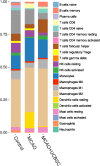Immunomodulation with Human Umbilical Cord Blood Stem Cells Ameliorates Ischemic Brain Injury - A Brain Transcriptome Profiling Analysis
- PMID: 31066288
- PMCID: PMC6719500
- DOI: 10.1177/0963689719836763
Immunomodulation with Human Umbilical Cord Blood Stem Cells Ameliorates Ischemic Brain Injury - A Brain Transcriptome Profiling Analysis
Abstract
Our group previously demonstrated that administration of a CD34-negative fraction of human non- hematopoietic umbilical cord blood stem cells (UCBSC) 48 h after ischemic injury could reduce infarct volume by 50% as well as significantly ameliorate neurological deficits. In the present study, we explored possible mechanisms of action using next generation RNA sequencing to analyze the brain transcriptome profiles in rats with ischemic brain injury following UCBSC therapy. Two days after ischemic injury, rats were treated with UCBSC. Five days after administration, total brain mRNA was then extracted for RNAseq analysis using Illumina Hiseq 2000. We found 275 genes that were significantly differentially expressed after ischemic injury compared with control brains. Following UCBSC treatment, 220 of the 275 differentially expressed genes returned to normal levels. Detailed analysis of these altered transcripts revealed that the vast majority were associated with activation of the immune system following cerebral ischemia which were normalized following UCBSC therapy. Major alterations in gene expression profiles after ischemia include blood-brain-barrier breakdown, cytokine production, and immune cell infiltration. These results suggest that UCBSC protect the brain following ischemic injury by down regulating the aberrant activation of innate and adaptive immune responses.
Keywords: human umbilical cord blood; immunomodulation; macrophage; microglia; neuroinflammation; stem cells; stroke.
Conflict of interest statement
Figures





References
-
- Xiao J, Nan Z, Motooka Y, Low WC. Transplantation of a novel cell line population of umbilical cord blood stem cells ameliorates neurological deficits associated with ischemic brain injury. Stem Cells Dev. 2005;14(6):722–733. - PubMed
-
- Hocum Stone LL, Xiao F, Rotschafer J, Nan Z, Juliano M, Sanberg CD, Sanberg PR, Kuzmin-Nichols N, Grande A, Cheeran MC, Low WC. Amelioration of ischemic brain injury in rats with human umbilical cord blood stem cells: mechanisms of action. Cell Transplant. 2016;25(8):1473–1488. - PubMed
-
- Donders R, Vanheusden M, Bogie JFJ, Ravanidis S, Thewissen K, Stinissen P, Gyselaers W, Hendriks JJA, Hellings N. Human Wharton’s jelly-derived stem cells display immunomodulatory properties and transiently improve rat experimental autoimmune encephalomyelitis. Cell Transplant. 2015;24(10):2077–2098. - PubMed
-
- Lin W, Hsuan YCY, Lin MT, Kuo TW, Lin CH, Su YC, Niu KC, Chang CP, Lin HJ. Human umbilical cord mesenchymal stem cells preserve adult newborn neurons and reduce neurological injury after cerebral ischemia by reducing the number of hypertrophic microglia/macrophages. Cell Transplant. 2017;26(11):1798–1810. - PMC - PubMed
-
- Wu KJ, Yu SJ, Chiang CW, Cho KH, Lee YW, Yen BL, Kuo LW, Wang Y. Transplantation of human placenta-derived multipotent stem cells reduces ischemic brain injury in adult rats. Cell Transplant. 2015;24(3):459–470. - PubMed
Publication types
MeSH terms
Grants and funding
LinkOut - more resources
Full Text Sources
Medical
Molecular Biology Databases

